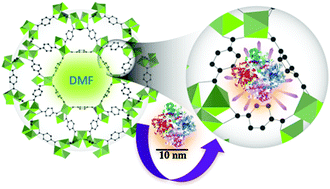Customized mesoporous metal organic frameworks engender stable enzymatic nanoreactors†
Abstract
Here, the porosity of a metal organic framework (MIL-101) is tailored by the choice of the solvent occupying the pores in a template free acid etching process. Employing a slightly basic solvent such as DMF afforded big pores around 30 nm (BP-MIL-101). Catalase (CAT), which is a large protein (6 × 10 nm), was successfully encapsulated by a diffusion-based method with a high capacity of 12.5%. BP-MIL-101 could successfully protect CAT from both digestion and denaturation while maintaining its catalytic activity. This paves the way for encapsulating different large biological targets for eventual translation and delivery.



 Please wait while we load your content...
Please wait while we load your content...